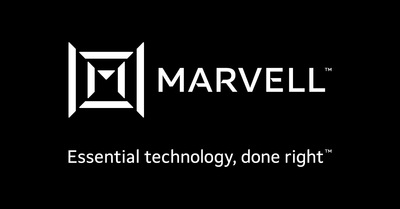Marvell Extends Automotive Networking Leadership with Launch of 802.3ch 10G Ethernet PHY
Marvell (NASDAQ: MRVL) has launched its new IEEE 802.3ch-based multi-gig automotive Ethernet PHY, designed for high-speed data transfer in connected vehicles. This PHY supports up to 10Gbps throughput, catering to advanced automotive features like driver assistance and 5G connectivity. The transition from domain-based to zonal architectures is facilitated by Marvell's technology, reducing costs and weight associated with conventional wiring. The PHY also integrates security features for data transmission, enhancing vehicle safety. It is currently available for customer sampling.
- Launch of 10Gbps multi-gig Ethernet PHY enhances Marvell's market leadership in automotive networking.
- Integrated security features promote safe data transmission in connected vehicles.
- Supports the transition from domain-based to zonal vehicle architectures, reducing wiring costs and weight.
- None.
Insights
Analyzing...
SANTA CLARA, Calif., April 27, 2021 /PRNewswire/ -- Marvell (NASDAQ: MRVL) today announced the availability of its IEEE 802.3ch-based multi-gig automotive Ethernet PHY which will enable the high-speed transfer of data in tomorrow's connected cars. Next generation vehicles that deploy advanced features such as driver assistance systems, 5G connectivity, and autonomous driving will require that massive amounts of data be moved quickly and efficiently within the car's in-vehicle network (IVN). By providing up to 10Gbps throughput data transmission for IVNs, Marvell's new PHY addresses the demand for ultra-high speed, secure and low latency data exchange on standards-based networks. Today's launch extends Marvell's market-leading position in automotive networking, following the company's 2018 introduction of the industry's first pre-standard, multi-gig automotive Ethernet PHY solution.
"To support the future of smarter and connected cars on the road, multi-gig Ethernet PHYs will enable high speed data transfer that is essential to powering advanced ADAS features in the vehicle," said Amir Bar-Niv, vice president of Marketing, Automotive Business Unit at Marvell. "We remain dedicated to delivering best-in-class solutions that meet the needs of the in-vehicle networking market, and we're proud to be one of the first suppliers to offer an 802.3ch capable Ethernet PHY with 2.5G, 5G and 10G Base-T1 support. In addition, with integrated 802.1AE MACsec, our newest PHY is securing these high-speed connections in next-generation automobiles."
Marvell's new automotive PHY, the 88Q4346, is essential as vehicle architectures are transitioning from domain-based to zonal-based platforms. In a domain-based architecture, Electronic Control Units (ECUs) of each domain are connected directly to the cameras, sensors and actuators across the car, requiring large amounts of cable to connect all end nodes. This cable harness is expensive, heavy and costly to install. In zonal-based architecture, Marvell's latest 10G PHY enables the aggregation of signals and protocols in each zone of the car over multi-gig Ethernet backbone, using a single pair of light weight cables, to reduce cost and power consumption in electrical vehicles.
Another driver for multi-gig IVN is the transition to 5G networks, which will enable almost instantaneous downloading of over-the-air applications and software updates as well as direct communication between vehicles, to improve safety and ultimately moving forward autonomous transportation. Marvell's multi-gig Ethernet PHY provides the high-speed and low latency that 5G networks require. In addition, this technology enables OEMs to leverage Ethernet's security and quality-of-service features to meet the demands of emerging vehicle-to-everything (infrastructure, pedestrians, cloud) communication.
"Carmakers are increasingly turning to our NVIDIA DRIVE Orin platform, which offers huge leaps in deep-learning processing, to power their next-generation vehicles," said Michael Truog, senior director of Automotive Platform Architecture at NVIDIA. "The DRIVE Orin platform can scale from level 2 to level 5 autonomy by aggregating multiple ECUs over a high-speed network. Leveraging Marvell's latest 10Gbps Ethernet PHY, NVIDIA can provide high-speed connectivity at multi-gig speeds to enable load balancing with low latency, delivering enormous performance capability."
"Ethernet is already ubiquitous and used in most modern vehicles. As we begin to roll out the next generation of vehicle architectures, solutions such as Marvell's multi-gig Ethernet PHY will be critical to support 5G connectivity, as well as the security and low-latency requirements for autonomous and connected cars," said Ian Riches, vice president of Automotive Practice and Director, Strategy Analytics Ltd.
Availability
The 88Q4346 PHY complements Marvell's existing multi-gig automotive switches and is currently sampling to an extensive list of customers planning the transition to next generation IVN architecture. Evaluation development boards are also available.
To learn more about Marvell's industry-leading automotive solutions, check out https://www.marvell.com/products/automotive/88Q4364.html.
About Marvell
To deliver the data infrastructure technology that connects the world, we're building solutions on the most powerful foundation: our partnerships with our customers. Trusted by the world's leading technology companies for 25 years, we move, store, process and secure the world's data with semiconductor solutions designed for our customers' current needs and future ambitions. Through a process of deep collaboration and transparency, we're ultimately changing the way tomorrow's enterprise, cloud, automotive, and carrier architectures transform—for the better.
Marvell and the M logo are trademarks of Marvell or its affiliates. Please visit www.marvell.com for a complete list of Marvell trademarks. Other names and brands may be claimed as the property of others.
For further information, contact:
Stacey Keegan
Vice President, Corporate Marketing
pr@marvell.com
SOURCE Marvell








